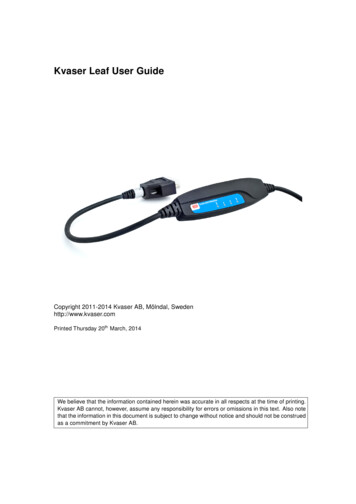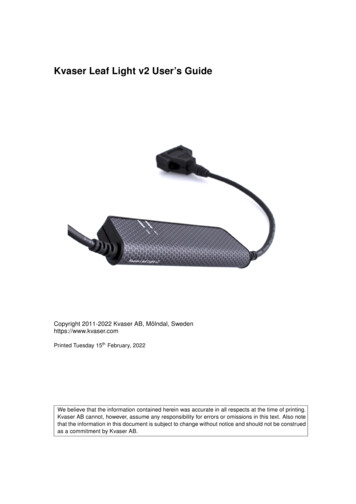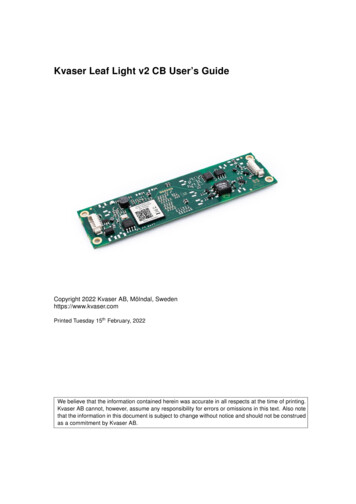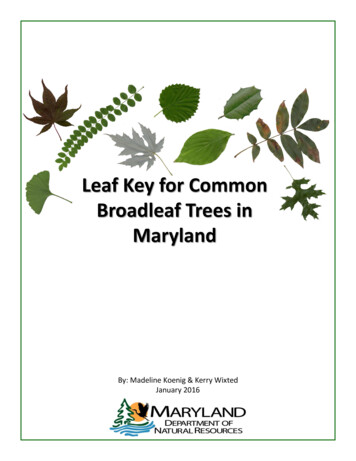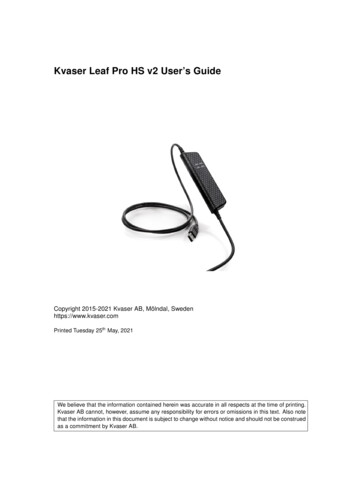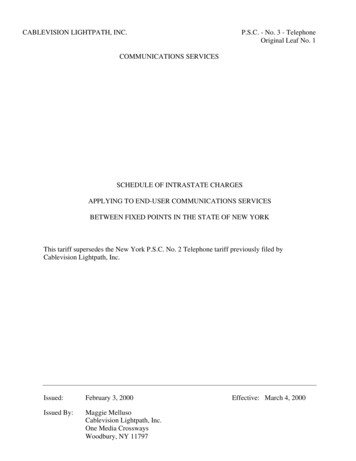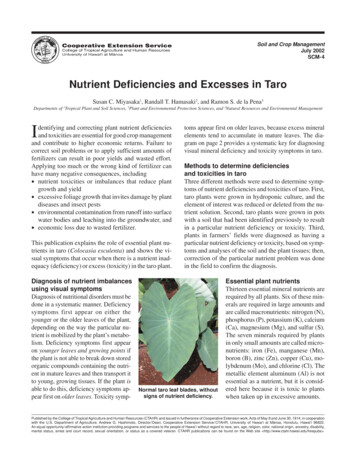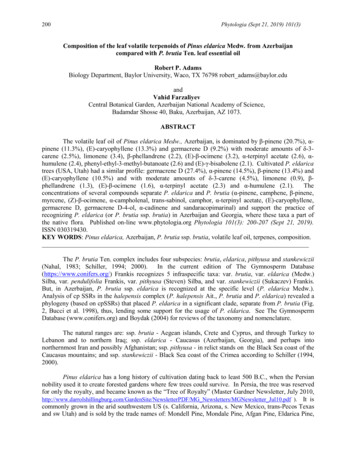
Transcription
200Phytologia (Sept 21, 2019) 101(3)Composition of the leaf volatile terpenoids of Pinus eldarica Medw. from Azerbaijancompared with P. brutia Ten. leaf essential oilRobert P. AdamsBiology Department, Baylor University, Waco, TX 76798 robert adams@baylor.eduandVahid FarzaliyevCentral Botanical Garden, Azerbaijan National Academy of Science,Badamdar Shosse 40, Baku, Azerbaijan, AZ 1073.ABSTRACTThe volatile leaf oil of Pinus eldarica Medw., Azerbaijan, is dominated by β-pinene (20.7%), αpinene (11.3%), (E)-caryophyllene (13.3%) and germacrene D (9.2%) with moderate amounts of δ-3carene (2.5%), limonene (3.4), β-phellandrene (2.2), (E)-β-ocimene (3.2), α-terpinyl acetate (2.6), αhumulene (2.4), phenyl-ethyl-3-methyl-butanoate (2.6) and (E)-γ-bisabolene (2.1). Cultivated P. eldaricatrees (USA, Utah) had a similar profile: germacrene D (27.4%), α-pinene (14.5%), β-pinene (13.4%) and(E)-caryophyllene (10.5%) and with moderate amounts of δ-3-carene (4.5%), limonene (0.9), βphellandrene (1.3), (E)-β-ocimene (1.6), α-terpinyl acetate (2.3) and α-humulene (2.1).Theconcentrations of several compounds separate P. eldarica and P. brutia (α-pinene, camphene, β-pinene,myrcene, (Z)-β-ocimene, α-campholenal, trans-sabinol, camphor, α-terpinyl acetate, (E)-caryophyllene,germacrene D, germacrene D-4-ol, α-cadinene and sandaracopimarinal) and support the practice ofrecognizing P. eldarica (or P. brutia ssp. brutia) in Azerbaijan and Georgia, where these taxa a part ofthe native flora. Published on-line www.phytologia.org Phytologia 101(3): 200-207 (Sept 21, 2019).ISSN 030319430.KEY WORDS: Pinus eldarica, Azerbaijan, P. brutia ssp. brutia, volatile leaf oil, terpenes, composition.The P. brutia Ten. complex includes four subspecies: brutia, eldarica, pithyusa and stankewiczii(Nahal, 1983; Schiller, 1994; 2000).In the current edition of The Gymnosperm Database(https://www.conifers.org/) Frankis recognizes 5 infraspecific taxa: var. brutia, var. eldarica (Medw.)Silba, var. pendulifolia Frankis, var. pithyusa (Steven) Silba, and var. stankewiczii (Sukaczev) Frankis.But, in Azerbaijan, P. brutia ssp. eldarica is recognized at the specific level (P. eldarica Medw.).Analysis of cp SSRs in the halepensis complex (P. halepensis Ait., P. brutia and P. eldarica) revealed aphylogeny (based on cpSSRs) that placed P. eldarica in a significant clade, separate from P. brutia (Fig.2, Bucci et al. 1998), thus, lending some support for the usage of P. eldarica. See The GymnospermDatabase (www.conifers.org) and Boydak (2004) for reviews of the taxonomy and nomenclature.The natural ranges are: ssp. brutia - Aegean islands, Crete and Cyprus, and through Turkey toLebanon and to northern Iraq; ssp. eldarica - Caucasus (Azerbaijan, Georgia), and perhaps intonorthernmost Iran and possibly Afghanistan; ssp. pithyusa - in relict stands on the Black Sea coast of theCaucasus mountains; and ssp. stankewiczii - Black Sea coast of the Crimea according to Schiller (1994,2000).Pinus eldarica has a long history of cultivation dating back to least 500 B.C., when the Persiannobility used it to create forested gardens where few trees could survive. In Persia, the tree was reservedfor only the royalty, and became known as the “Tree of Royalty” (Master Gardner Newsletter, July NewsletterPDF/MG Newsletters/MGNewsletter Jul10.pdf ). It iscommonly grown in the arid southwestern US (s. California, Arizona, s. New Mexico, trans-Pecos Texasand sw Utah) and is sold by the trade names of: Mondell Pine, Mondale Pine, Afgan Pine, Eldarica Pine,
Phytologia (Sept 21, 2019)101(3)201Desert Pine, Goldwater Pine, Elder Pine, and Lone Star Christmas tree. Mondell pine was introduced intothe US in 1961 when the USDA obtained five pounds of P. eldarica from Afghanistan and gave it toUniversities to determine it test its adaptability and potential.In Azerbaijan it may assume a gnarly shape (Fig. 1) and grows on rock slopes (Fig. 2). In theUSA, it is grown as an ornamental tree along streets (Figs. 3, 4) and in gardens. It is said to be short livedin central Texas (10-15 yrs), but in the dry deserts of southwestern US, it is grown under drip irrigation inthe arid lands that seem to favor long life, as in Azerbaijan.Fig. 1. Habit of Pinus eldarica in Azerbaijan.Fig. 3. P. eldarica (Mondell Pine) growing,drip irrigated, in Stone Cliff, Utah, USA.Fig. 2. P. eldarica on rock slope, Azerbaijan.Fig. 4 P. eldarica (Mondell Pine) growing as a streettree, drip irrigated, in Stone Cliff, St. George, Utah, USA.The volatile leaf oils of Pinus brutia (usually including P. eldarica) have been the subject ofseveral studies (Gohsn et al. 2006; Ioannou et al. 2014; Mitic, et al. 2017; Roussis et al. 1995; Sezik et al.2008; Vidrich et al. 1999). But, no studies were found on the volatile leaf oil composition of P. eldaricafrom a natural population in Azerbaijan. However, Chubinidze et al. (1999) reported on themonoterpenes from Georgian P. eldarica in young vs. old needles and young vs. old cortex (Table 1).
202Phytologia (Sept 21, 2019) 101(3)They found the needle oils were dominated α-pinene, δ-3-carene and limonene, and the cortex (wood) oilsreflected the same patterns in young and old needles (Table 1).Table 1. Variation in monoterpene concentrations from leaves and wood cortex of P. eldarica fromGeorgia (former USSR). Adapted from Chubinidze et al. (1999).cpd\ g needles48.8%2.12.322.410.25.02.14.12.0old needles78.38.85.03.11.00.00.03.80.8young cortex35.82.15.410.920.825.00.00.00.0old cortex73.43.26.74.85.66.00.00.00.3Although several other papers cited P. eldarica volatile analyses, their samples were obtainedfrom cultivated materials of unknown source. The purpose of this paper is to report on the volatile leaf oilfrom P. eldarica from a natural population in Azerbaijan and compare that oil with other analyses waswell as with that of P. brutia (ssp. brutia) oils.MATERIALS AND METHODSLeaf samples collected: Pinus eldarica, Azerbaijan, 41 10' 42.76" N, 46 13' 55.04" E., 241 m.Coll. Vahid Farzaliyev 1-9, 12 April 2019, Lab Acc. Robert P. Adams 15607-15615(9). In addition,samples from cultivated P. eldarica (locally called Mondell Pine) were collected from Stone Cliffsubdivision, St. George, UT, USA, 22 March 2019, 37 04' 45" N, 113 32' 16" W, 844 m, WashingtonCo., Utah, USA. Coll. Robert P. Adams 15574-15579(6).Voucher specimens are deposited in theherbarium, Baylor University.Gently dried leaves (100g, 40 - 45 C) were steam distilled for 2 h using a circulatory Clevengertype apparatus (Adams, 1991). The oil samples were concentrated (ether trap removed) with nitrogen andthe samples stored at -20ºC until analyzed. The extracted leaves were oven dried (100ºC, 48 h) fordetermination of oil yields.The oils were analyzed on a HP5971 MSD mass spectrometer, scan time 1/ sec., directly coupledto a HP 5890 gas chromatograph, using a J & W DB-5, 0.26 mm x 30 m, 0.25 micron coating thickness,fused silica capillary column (see Adams, 2007 for operating details). Identifications were made bylibrary searches of the Adams volatile oil library (Adams, 2007), using the HP Chemstation library searchroutines, coupled with retention time data of authentic reference compounds. Note that limonene and βphellandrene elute as a single peak on DB-5, but their amounts can be quantitated by the ratio of masses68, 79 (limonene) and 77, 93 (β-phellandrene). Quantitation was by FID on an HP 5890 gaschromatograph using a J & W DB-5, 0.26 mm x 30 m, 0.25 micron coating thickness, fused silicacapillary column using the HP Chemstation software.RESULTS AND DISCUSSIONThe volatile leaf oils of Pinus eldarica (and P. brutia) contain considerable amounts of β-pinene(20.7%), α-pinene (11.3%), (E)-caryophyllene (13.3%) and germacrene D (9.2%) with lesserconcentrations of δ-3-carene (2.5%), limonene (3.4), β-phellandrene (2.2), (E)-β-ocimene (3.2), α-terpinyl
Phytologia (Sept 21, 2019)101(3)203acetate (2.6), α-humulene (2.4), phenyl-ethyl-3-methyl-butanoate (2.6), and (E)-γ-bisabolene (2.1).Cultivated P. eldarica trees (USA, Utah) had a similar profile dominated by germacrene D (27.4%), αpinene (14.5%), β-pinene 13.4%) and (E)-caryophyllene (10.5%) and with moderate amounts of δ-3carene (4.5%), limonene (0.9), β-phellandrene (1.3), (E)-β-ocimene (1.6), α-terpinyl acetate (2.3) and αhumulene (2.1).The oil from samples from the natural stand in Azerbaijan differs quantitatively in somecompounds from that of the cultivated P. eldarica in the USA (both were extracted and analyzed byidentical methods). This is apparent (Table 2) in the concentrations of α-pinene (11.3%, 14.5%), βpinene (20.7,13.4), δ-3-carene (2.5, 4.5), limonene (3.4, 0.9), β-phellandrene (2.2, 1.3), (E)-caryophyllene(13.3, 10.5), and germacrene D (9.2, 27.4).The oil analysis from Iran (Sulriman and San’aty (2005) was generally quite similar to that fromAzerbaijan and USA, but differed in having some unusual components (red, Table 2): citronellol,citronellyl formate, elemicin, and geranyl isovalerate. These compounds, usually minor, may have comefrom cross-contamination with an essential oil containing these compounds.Analyses (from the literature) for plants from Italy (red, Table 2) differ considerably fromAzerbaijan in some components (cf. β-pinene (1.4%, Italy), α-terpinyl acetate (54.3%, Italy), germacreneD (missing, Italy), along with several other components missing in the Italy analysis of Vidrich et al.1999. The high amount of α-terpinyl acetate (54.3%) is inconsistent with other oils of P. eldarica (Table2), and seems to be spurious.The question of the distinctness of P. eldarica and P. brutia (ssp. brutia) is addressed in the oilanalyses as we have included two analyses of P. brutia from a native, Lebanon stand, and cultivated inGreece in Table 2. Several compounds separate P. eldarica and P. brutia (green and yellow, Table 2)including α-pinene, camphene, β-pinene, myrcene, (Z)-β-ocimene, α-campholenal, trans-sabinol,camphor, α-terpinyl acetate, (E)-caryophyllene, germacrene D, germacrene D-4-ol, α-cadinene andsandaracopimarinal. Several of these are qualitative differences, but most of these are in lowconcentrations and may have been found (or reported) in other analysis in P. brutia. Still, the overallpattern is clear that the oils of P. eldarica and P. brutia do differ in several components, and this seems tosupport the practice of recognizing P. eldarica (or as P. brutia ssp. brutia) in Azerbaijan and Georgia,where these taxa are part of the native flora.A comparison of the oils of individuals of P. eldarica cultivated in St. George, Utah, USA,revealed considerable variation with 3 to 5 fold differences between lowest and highest values (Table 3):α -pinene (6.2 - 19.7%); α -pinene (5.0 - 24.3%); δ-3-carene (1.1 - 7.6%); terpinolene (0.2 - 2.5%); αterpinyl acetate (1.6 - 3.3%); (E)-caryophyllene (6.6 - 19.4%) and germacrene D (21.6 - 39.0%). Thislarge amount of variation reflects the origin of all P. eldarica (Mondell pine, etc.) in the US that wereobtained by growing seedlings from the USDA bulk lot of seeds from Afghanistan in 1961. It is verypossible that the Afghanistan P. eldarica might have actually come from Persia originally, and thePersian P. eldarica pines were likely from Azerbaijan (or less likely, Georgia).There is a suggestion that two chemotypes (or races) might exist in P. eldarica as one can see thatseveral trees have a similar oil profile (15576, 15579, 15575, blue, Table 3) with higher α-pinene, αpinene and δ-3-carene and trees 15578, 1577 and 1574 )yellow, Table 3) are higher in germacrene D and(E)-caryophyllene. Additional sampling is needed to confirm if chemical races exist in nature.
204Phytologia (Sept 21, 2019) 101(3)ACKNOWLEDGEMENTSThis research supported with funds from Baylor University.LITERATURE CITEDAdams, R. P. 1991. Cedarwood oil - Analysis and properties. pp. 159-173. in: Modern Methods of PlantAnalysis, New Series: Oil and Waxes. H.-F. Linskens and J. F. Jackson, eds. Springler- Verlag,Berlin.Adams, R. P. 2007. Identification of essential oil components by gas chromatography/ massspectrometry. 4th ed. Allured Publ., Carol Stream, IL.Boydak, M. Silvicultural characteristics and natural regeneration of Pinus brutia Ten. - a review. PlantEcology 171: 153-163.Bucci, G., M. Anzidel, A. Madaghiele and G. G. Vendramin. 1998. Detection of haplotypic variation andnatural hybridization in halepensis-complex pine species using chloroplast simple sequence repeat(SSR) markers. Molec. Ecology 7: 1633-1643.Chubinize, V., T. Beriashvili, N. Kekelidze and D. Chubinidze. 1999. Investigation of volatile oil ofPinus eldarica Medw. Bull. Georgian Acad. Sciences 160: 550-552.Gohsn, M. W., N. A. Saliba and S. Y. Talhouk. 2006. Chemical composition of the needle-twig oils ofPinus brutia Ten. J. Ess. Oil Res. 18: 445-447.Mitic, Z. S., S. C. Jonanovic, B. K. Zlatkovic, B. M. Nikolic, G. S. Stojanocia and P. D. Marin. 2017.Needle terpenes as chemotaxonomic markers in Pinus: subsections Pinus and Pinaster. Chem.Biodiversity 14, e1600453, DOI: 10.1002/cbdv.201600453. 14 pp.Nahal, I. 1983. Le pin brutia (Pinus brutia Ten. subsp. brutia) (premiere partie). Foret Mediterraneenne 5:165-172.Ioannou, E., A. Koutsaviti, O. Tzakou and V. Roussis. 2014. The genus Pinus: a comparative study on theneedle essential oil composition of 46 pine species. Phytochem. Rev. DOI 10.1007/s11101-014-93384.Roussis, V., P. V. Petrakis, A. Ortiz and B. E. Mazomenos. 1995. Volatile constituents of needles offiver Pinus species grown in Greece. Phytochemistry 39: 357-361.Schiller, G. 1994. Diversity among P. brutia ssp. brutia and related taxa - a review. I. U. Orman FakultesiDergisi A 44: 133-147.Schiller, G. 2000. Inter- and intra-specific genetic diversity of Pinus halepensis Mill. and P. brutia Ten.,pp. 13-35. In: Ecology, biogeography and management of Pinus halepensis and P. brutia forestecosystems in the Mediterranean Basin. G. Ne’eman and L. Trabaud (eds.), Backhuys Pub., Leiden.Sezik, E,, O. Ustun, M. Kurkcuoglu and K. H. C. Baser. 2008. Chemical compositions of the needleessential oils obtained from Pinus brutia Ten. growing in Turkey. Acta Pharmaceutica Sciencia 50:85-96.Vidrich, V., P. Fusi, M. Michelozzi and M. France. 1999. Chemicals of Pinus brutia Ten. from differentprovenances. Agrochimica 43: 206-214.
205Phytologia (Sept 21, 2019)101(3)Table 2. The leaf oil constituents of Pinus eldarica from a natural, endemic population in Azerbaijan,compared with P. eldarica cultivated in the USA, Italy and Iran. Also included are analyses of thevolatile leaf oils from the closely related (conspecific?) species, P. brutia. Compounds that differ inamounts between P. eldarica and P. brutia are highlighted in 1315221529β-phellandrene(Z)-β-ocimene(E)- l acetatecitronellollinalool acetatecitronellyl formatebornyl acetatetrans-piperitol acetateα-terpinyl acetateα-copaenegeranyl acetateβ-bourboneneβ-elemenemethyl rene Dphenyl-ethyl-3-me-butanoateγ-amorphenemethyl neγ-cadineneδ-cadinene(E) γ -bisaboleneP. 413.3t2.40.4t9.22.60.3t0.30.30.20.52.1P. eldarica P. eldaricacult. USA. U cult. IranSt. George .30.2t0.20.20.50.50.71.31.7-P. eldaricacult. Italy212.80.22.1t1.40.6tt4.0P. 25.91.514.50.80.50.41.9-P. -
71018901958198721842200230024002443Phytologia (Sept 21, 2019) 101(3)compoundP. crene-D-4-ol0.2caryophyllene oxide1.3humulene epoxide II0.3β-atlantol0.3geranyl isovalerateepi-α-cadinol ( T-cadinol)tphenyl ethyl 0.6sesquiterpene alcohol?, 43,79,67 0.9192, FW 222?iso-pimara-8(14),15-dienemanool oxide0.6sandaracopimarinal0.3docosane (C22)ttricosane (C23)ttetracosane (C24)tmethyl neoabietatetP. eldarica P. eldaricacult. USA. U cult. IranSt. George t0.20.30.2-P. eldaricacult. Italy20.9-P. brutianatural,Lebanon30.3-P. brutiacult.Greece4-Suleiman and San’aty (2005), 2Vidrich et al. (1999), 3Ghosn and Saliba (2006), Roussis et al. (1995).1KI Kovat’s Index (linear), t trace, 0.05%.
207Phytologia (Sept 21, 2019)101(3)Table 3. Variation in composition among six P. eldarica trees oil., cultivated, using drip irrigation, in St.George, Utah, USA. Components never larger than a trace (t) are llandrene1.1(Z)-β-ocimene0.3(E)- inen-4-oltα-terpineol0.2myrtenoltbornyl acetate0.2trans-piperitol acetate0.1α-terpinyl tgermacrene D21.7phenyl-ethyl-3-me-butanoate ophyllene oxide0.4humulene epoxide IItβ-atlantoltepi-α-cadinol ( T-cadinol)tphenyl ethyl ara-8(14),15-dienetmanool oxidetsandaracopimarinaltdocosane (C22)ttricosane (C23)ttetracosane (C24)0.3methyl neoabietatetP. eldarica15576P. eldarica15579P. eldarica15575P. eldarica15578P. .61.60.70.3ttt0.20.10.50.4t0.1t0.20.30.3P. eldaricacult. 60.20.1P. eldaricacult. USA.Ranget - 0.1t - 0.16.2 - 19.70.1 - 0.3t -0.75.0 - 24.30.6 - 1.0t - 0.11.1 - 7.5t - 0.1t - 0.10.5 - 1.30.8 - 2.00.2 - 0.61.0 - 4.00.1 - 0.10.2 - 1.5t - 0.7t - 0.1t - 0.3t - 0.3t - 0.2t - 0.2t - 0.2t - 0.1t - 0.4t - 0.21.6 - 3.3t - 0.20.3 - 1.1t - 0.10.1 - 0.46.6 - 19.40.1 - 0.31.3 - 3.9t - 1.1t - 0.121.6 - 39.00.6 -1.90.2 - 0.90.2 - 0.50.1 - 0.50.2 - 1.10.3 - 2.80.6 - 1.00.3 - 0.5t - 0.1t - 0.1t - 0.1t - 0.2t - 0.10.3 - 0.7t - 0.6t - 0.1t - 0.9t - 0.5t - 0.60.2 - 0.5t - 0.3
Desert Pine, Goldwater Pine, Elder Pine, and Lone Star Christmas tree. Mondell pine was introduced into the US in 1961 whenthe USDA obtainedfive pounds of . P. eldaricafrom Afghanistan and gave it to . Universities to determine it test its adaptability and potential. In Azerbaijan it may assume a gnarly shape (Fig. 1) and grows on rock slopes .


